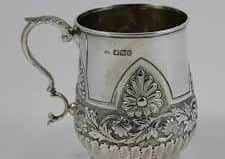COLUMN: Talking antiques with Pete Robbins


Solid silver is often confused with silver plate, which is just a base metal with a very thin layer of silver applied to it, or EPNS which stands for Electroplated Nickel Silver.
The hallmark on a piece of solid silver contains marks which gives the age, town or city where it was assayed and a lion to denote the sterling standard of purity, which in England means at least 925 parts per 1000 silver, and even the name of the silversmith responsible by way of their initials.
Advertisement
Hide AdAdvertisement
Hide AdThe major assay offices all had their own marks which ranged from a leopard’s head for London, three wheat-sheaves for Chester, Birmingham has an anchor and Sheffield a crown. The latter two symbols were chosen after the cities of Sheffield and Birmingham had petitioned for their own assay offices in 1773 and had met in a pub called the Crown & Anchor. There were also assay offices in Exeter, York, Norwich, Newcastle and in Scotland and Ireland. To me it was the fact that you could have something in your hand and tell exactly when and where it was made and by whom that made silver slightly magical. The value of silver items can vary wildly; this can be down to where it was assayed or who the silversmith was. Items by certain silversmiths like Nathaniel Mills can fetch huge amounts; and also the weight of the silver itself, often referred to as scrap value.


The price of silver fluctuates on an hourly basis, similar to that of oil, and therefore an item that weighs 10 ounces can be worth £120 one month and quite easily drop to less than £90 less than a month later.
The first pieces of silver I collected were very basic items such as sugar tongs, spoons and vesta cases, but even these can vary wildly in price, for instance a simple vesta case today may only be worth £30-40 yet one with a picture on the front of a scantily clad lady can fetch ten times that or more.
Walking round an antiques fair in Harrogate last week I was in awe of some of the fantastic and ornate pieces shining in the glass display cabinets; large punch bowls, table centre pieces and six table place markers in the shape of small frogs whose tongues popped out when the name card was inserted, all commanding huge three and four figure sums.
Advertisement
Hide AdAdvertisement
Hide AdThe finest piece of silver work I have seen though has to be on display at the Bowes Museum in Barnard Castle. The centrepiece of their collection is a huge life-size mechanical silver swan which dates from 1773 and each day at 2pm is wound up and proceeds to twist left, right and then bend down to pick up small silver fish from the water beneath it. This is worth the entrance fee itself and no matter what the price of silver that day it is truly priceless. So next time you are having a cup of tea or setting the table for lunch turn over the cutlery and have a look on the back; chances are it will say stainless steel but it may just have four little marks, one a lion, one a date letter and two others, and with a little bit of detective work on the internet or from a book from the library you will be able to show off and tell your friends when and where it was made and who made it.


However to temper your excitement a little, silver plate or EPNS often had what appear to be hallmarks stamped on the back; these were designed to do exactly that, to fool the casual observer into thinking the owners had solid silver when in fact they had the far less valuable silver plate.